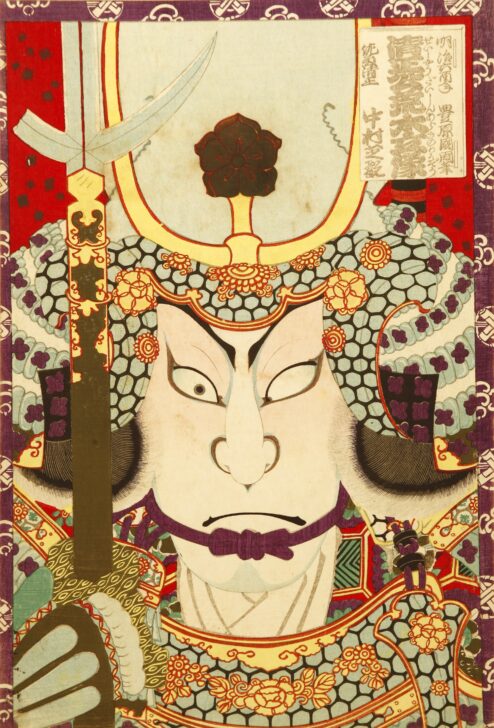Rough Wooden Statue of Minister Seishō: Nakamura Shikan IV as the Warrior Satō Kiyomasa
Toyohara Kunichika

Description
In Focus - 2013
Actor Prints from the Stuart Katz Collection
Kabuki, a popular type of Japanese theater, originated in the early seventeenth century, developing into a sophisticated, highly choreographed form in subsequent centuries. Still wildly popular in contemporary Japan, kabuki is characterized by all-male casts (female roles are played by specially trained male actors), ostentatious costumes and makeup, and stylized movements. Star kabuki actors were favorite subjects of ukiyo-e (literally: pictures of the floating world), a genre of Japanese prints and paintings depicting worldly pleasures, as seen in these three images created between the end of the Edo Period (1615–1867) and the beginning of the Showa Period (1926–1989).
In these prints, the artists portray close-up views of the actors’ faces in their memorable kabuki roles—a format popular since the late eighteenth century. They capture the heightened moments in climactic scenes called mie, when an actor’s body and facial expressions move incrementally and pose for a few seconds at a time; the position of the eyes can be as powerful as the movement of the body. In two of the prints, actors Nakamura Shikan IV and Kataoka Ichizô I fix their eyes to convey the prowess of their characters—one as a fearless warrior and the other as a strong sumo wrestler. The depiction of Actor Sawamura Gennosuke IV as Niki Danjô Hiding under the Floor by Natori Shunsen represents a new trend of the actor print genre in the early twentieth century, in which the facial expression of the actor appears more naturalistic.
Stuart Katz, who earned his PhD degree in social psychology from the University of Michigan in 1971, recently retired from teaching at the University of Georgia. Dr. Katz began collecting Japanese prints, as well as paintings from Japan, China, and Korea, in the 1970s. Since his first generous gift to UMMA in 2006 and over many years, Dr. Katz has helped to expand the Museum’s strong Japanese holdings.
Natsu Oyobe
Associate Curator of Asian Art
[LABEL TEXT]
Natori Shunsen
Japanese, 1886–960
Actor Sawamura Gennosuke IV as Niki Danjô Hiding under the Floor
1925–1929
Japan, Taishô Era (1912-1926)
Color woodblock print on paper
Gift of Stuart Katz, 2008/2.8
Utagawa Hirosada
Japan, circa 1826 – 1865
Actor Kataoka Ichizô as Sumo Wrestler Onigatake
1848
Japan, Edo Period (1615–1868)
Color woodblock print on paper
Gift of Stuart Katz, 2006/2.69
Toyohara Kunichika
Japan, 1835-1900
Actor Nakamura Shikan IV as Kato Kiyomasa
1873
Japan, Meiji Era (1868–1912)
Color woodblock print on paper
Gift of Stuart Katz, 2009/2.21
Subject Matter:
Actor Nakamura Shikan IV was born into the Nakamura family of kabuki actors in Edo (present-day Tokyo) in 1810. He was active from the time he was a child in 1813 until his death in 1847. He was known for his roles as both tachiyaku (lead protagonist) and young onnagata (“female form” or “female role”).
Physical Description:
This is a portrait of a warrior. He wears elaborately decorated armor and a horned helmet. A purple chord is tied over his chin. In his right hand he holds a metal weapon. A purple border with white crests is printed along the side and top edges.
Inscriptions: Meiji 6 tori nen; Toyohara Kunichika-hitsu; Kiyomasa daijin araki no ryūzō; Satō Masakiyo, Nakamura Shikan
Usage Rights:
If you are interested in using an image for a publication, please visit https://umma.umich.edu/request-image/ for more information and to fill out the online Image Rights and Reproductions Request Form.